Pore Structure and Heterogeneity Characteristics of Coal-Bearing Marine–Continental Transitional Shales from the Longtan Formation in the South Sichuan Basin, China
Abstract
:1. Introduction
2. Geological Setting
3. Materials and Methods
3.1. Materials
3.2. TOC and Mineralogical Experiments
3.3. SEM and N2 Adsorption–Desorption Experiments
3.4. Fractal Dimension Calculation
4. Results
4.1. TOC and Mineralogy
4.2. Pore Shapes Based on SEM and N2 Adsorption–Desorption Isotherms
4.3. Pore Structure Parameters
4.4. Pore Size Distribution
4.5. Fractal Dimensions
5. Discussion
5.1. The Coupling Mechanism between Pore Structure Parameters
5.2. The Influence of Heterogeneity on Pore Structure
5.3. Compositional Controls on Pore Structure
5.4. Compositional Controls on Heterogeneity
6. Conclusions
Author Contributions
Funding
Data Availability Statement
Conflicts of Interest
References
- Curtis, J.B. Fractured shale-gas systems. AAPG Bull. 2002, 86, 1921–1938. [Google Scholar]
- Wang, H.; Li, J.; Zhao, Q.; Lin, Y. Resources and development of new energy in China. Acta Petrol. Sin. 2009, 30, 469–474. [Google Scholar]
- Selley, R.C. UK shale gas: The story so far. Mar. Pet. Geol. 2012, 31, 100–109. [Google Scholar] [CrossRef]
- Johnson, C.; Boersma, T. Energy (in) security in Poland the case of shale gas. Energy Policy 2013, 53, 389–399. [Google Scholar] [CrossRef]
- Liang, C.; Jiang, Z.; Zhang, C.; Guo, L.; Yang, Y.; Li, J. The shale characteristics and shale gas exploration prospects of the Lower Silurian Longmaxi shale, Sichuan Basin, South China. J. Nat. Gas Sci. Eng. 2014, 21, 636–648. [Google Scholar] [CrossRef]
- Daly, H.E.; Walton, M.A. Energy Access Outlook: From Poverty to Prosperity, World Energy Outlook-2017 Special Report. Available online: https://www.oecd-ilibrary.org/energy/energy-access-outlook-2017_9789264285569-en (accessed on 10 January 2019).
- Fu, C.Y. China’s shale gas and shale oil resources: Opportunities and challenges. Energy Explor. Exploit. 2014, 32, 759–770. [Google Scholar] [CrossRef]
- Ma, Y.S.; Cai, X.Y.; Zhao, P.R. China’s shale gas exploration and development: Understanding and practice. Pet. Explor. Dev. 2018, 45, 589–603. [Google Scholar] [CrossRef]
- Ding, C.; He, J.; Wu, H.; Zhang, X. Nanometer pore structure characterization of taiyuan formation shale in the lin-xing area based on nitrogen adsorption experiments. Minerals 2021, 11, 298. [Google Scholar] [CrossRef]
- Loucks, R.G.; Reed, R.M.; Ruppel, S.C.; Jarvie, D.M. Morphology, genesis, and distribution of nanometer-scale pores in siliceous mudstones of the Mississippian Barnett shale. J. Sediment. Res. 2009, 79, 848–861. [Google Scholar] [CrossRef]
- Loucks, R.G.; Reed, R.M.; Ruppel, S.C.; Hammes, U. Spectrum of pore types and networks in mudrocks and a descriptive classification for matrix-related mudrock pores. AAPG Bull. 2012, 96, 1071–1098. [Google Scholar] [CrossRef]
- Chalmers, G.R.L.; Bustin, R.M. The organic matter distribution and methane capacity of the Lower Cretaceous strata of Northeastern British Columbia, Canada. Int. J. Coal Geol. 2007, 70, 223–239. [Google Scholar] [CrossRef]
- Ross, D.J.K.; Bustin, R.M. The importance of shale composition and pore structure upon gas storage potential of shale gas reservoirs. Mar. Pet. Geol. 2009, 26, 916–927. [Google Scholar] [CrossRef]
- Clarkson, C.R.; Freeman, M.; He, L.; Agamalian, M.; Melnichenko, Y.B.; Mastalerz, M.; Bustin, R.M.; Radlinski, A.P.; Blach, T.P. Characterization of tight gas reservoir pore structure using USANS/SANS and gas adsorption analysis. Fuel 2012, 95, 371–385. [Google Scholar] [CrossRef]
- Pollastro, R.M.; Jarvie, D.M.; Hill, R.J.; Adams, C.W. Geologic framework of the Mississippian Barnett Shale, Barnett-Paleozoic total petroleum system, Bend arch–Fort Worth Basin, Texas. AAPG Bull. 2007, 91, 405–436. [Google Scholar] [CrossRef]
- Nelson, P.H. Pore throat sizes in sandstones, tight sandstones, and shales. AAPG Bull. 2009, 93, 329–340. [Google Scholar] [CrossRef]
- Chalmers, G.R.; Bustin, R.M.; Power, I.M. Characterization of gas shale pore systems by porosimetry, pycnometry, surface area, and field emission scanning electron microscopy/transmission electron microscopy image analyses: Examples from the Barnett, Woodford, Haynesville, Marcellus, and Doig unit. AAPG Bull. 2012, 96, 1099–1119. [Google Scholar] [CrossRef]
- Chalmers, G.R.L.; Ross, D.J.K.; Bustin, R.M. Geological controls on matrix permeability of Devonian Gas Shales in the Horn River and Liard basins, northeastern British Columbia, Canada. Int. J. Coal Geol. 2012, 103, 120–131. [Google Scholar] [CrossRef]
- Liu, X.J.; Xiong, J.; Liang, L.X. Investigation of pore structure and fractal characteristics of organic–rich Yanchang formation shale in central China by nitrogen adsorption/desorption analysis. J. Nat. Gas Sci. Eng. 2015, 22, 62–72. [Google Scholar] [CrossRef]
- Niu, X.; Yan, D.; Hu, M.; Liu, Z.; Zuo, M. Controls of distinct mineral compositions on pore structure in over-mature shales: A case study of Lower Sambrian Niutitang shales in South China. Minerals 2021, 11, 51. [Google Scholar] [CrossRef]
- Zhang, J.Z.; Lin, W.; Li, M.T.; Wang, J.G.; Xiao, X.; Li, Y.; Zhang, X.C. Evolution Mechanism of Microscopic Pore System in Coal-Bearing Marine–Continental Transitional Shale with Increasing Maturation. Minerals 2023, 13, 1482. [Google Scholar] [CrossRef]
- Curtis, M.E.; Ambrose, R.; Sondergeld, C.H.; Rai, C.S. Investigation of the Relationship between Organic Porosity and Thermal Maturity in The Marcellus Shale. In Proceedings of the North American Unconventional Gas Conference and Exhibition, The Woodlands, TX, USA, 14–16 June 2011; Volume 144370, pp. 1–4. [Google Scholar]
- Li, J.; Zhou, S.; Li, Y.; Ma, Y.; Yang, Y.; Li, C. Effect of organic matter on pore structure of mature lacustrine organic-rich shale: A case study of the Triassic Yanchang shale, Ordos Basin, China. Fuel 2016, 185, 421–431. [Google Scholar] [CrossRef]
- Montgomery, S.L.; Jarvie, D.M.; Bowker, K.A.; Pollastro, R.M. Mississippian Barnett Shale, Fort Worth basin, north-central Texas: Gas-shale play with multi–trillion cubic foot potential. AAPG Bull. 2005, 90, 963–966. [Google Scholar] [CrossRef]
- Hill, R.J.; Zhang, E.; Katz, B.J.; Tang, Y. Modeling of gas generation from the Barnett Shale, Fort Worth Basin, Texas. AAPG Bull. 2007, 91, 501–521. [Google Scholar] [CrossRef]
- Ross, D.J.K.; Bustin, R.M. Impact of mass balance calculations on adsorption capacities in microporous shale gas reservoirs. Fuel 2007, 86, 2696–2706. [Google Scholar] [CrossRef]
- Ross, D.J.K.; Bustin, R.M. Shale gas potential of the Lower Jurassic Gordondale Member, northeastern British Columbia. Bull. Can. Pet. Geol. 2007, 55, 51–75. [Google Scholar] [CrossRef]
- Ross, D.J.K.; Bustin, R.M. Characterizing the shale gas resource potential of Devonian-Mississippian strata in the Western Canada sedimentary basin: Application of an integrated formation evaluation. AAPG Bull. 2008, 92, 87–125. [Google Scholar] [CrossRef]
- Li, A.; Ding, W.; He, J.; Dai, P.; Yin, S.; Xie, F. Investigation of pore structure and fractal characteristics of organic-rich shale reservoirs: A case study of Lower Cambrian Qiongzhusi formation in Malong block of eastern Yunnan Province, South China. Mar. Pet. Geol. 2016, 70, 46–57. [Google Scholar] [CrossRef]
- Chalmers, G.R.L.; Bustin, R.M. Lower Cretaceous gas shales in northeastern British Columbia, Part I: Geological controls on methane sorption capacity. Bull. Can. Pet. Geol. 2008, 56, 1–21. [Google Scholar] [CrossRef]
- Jarvie, D.M. Shale Resource Systems for Oil and Gas: Part 1—Shale-gas Resource Systems. AAPG Mem. 2012, 97, 89–119. [Google Scholar]
- Slatt, R.M.; O’Brien, N.R. Pore types in the Barnett and Woodford gas shales: Contribution to understanding gas storage and migration pathways in fine-grained rocks. AAPG Bull. 2011, 95, 2017–2030. [Google Scholar] [CrossRef]
- Li, Z.W.; Tang, Z.L.; Zheng, W.Q. Micropore Structural Heterogeneity of Siliceous Shale Reservoir of the Longmaxi Formation in the Southern Sichuan Basin, China. Minerals 2019, 9, 548. [Google Scholar] [CrossRef]
- Jarvie, D.M.; Hill, R.J.; Ruble, T.E.; Pollastro, R.M. Unconventional shale-gas systems: The Mississippian Barnett Shale of north-central Texas as one model for thermogenic shale-gas assessment. AAPG Bull. 2007, 91, 475–499. [Google Scholar] [CrossRef]
- Fishman, N.S.; Hackley, P.C.; Lowers, H.A.; Hill, R.J.; Egenhoff, S.O.; Eberl, D.D.; Blum, A.E. The nature of porosity in organic-rich mudstones of the Upper Jurassic Kimmeridge Clay Formation, North Sea, offshore United Kingdom. Int. J. Coal Geol. 2012, 103, 32–50. [Google Scholar] [CrossRef]
- Hu, H.; Hao, F.; Lin, J.; Lu, Y.; Ma, Y.; Li, Q. Organic matter-hosted pore system in the Wufeng-Longmaxi (O3w-S11) shale, Jiaoshiba area, Eastern Sichuan Basin, China. Int. J. Coal Geol. 2017, 173, 40–50. [Google Scholar] [CrossRef]
- Klaver, J.; Hemes, S.; Houben, M.; Desbois, G.; Radi, Z.; Urai, J.L. The connectivity of pore space in mudstones: Insights from high-pressure Wood’s metal injection, BIB–SEM imaging, and mercury intrusion porosimetry. Geofluids 2015, 15, 577–591. [Google Scholar] [CrossRef]
- Curtis, M.E.; Sondergeld, C.H.; Ambrose, R.J.; Rai, C.S. Microstructural investigation of gas shales in two and three dimensions using nanometer–scale resolution imaging. AAPG Bull. 2012, 96, 665–677. [Google Scholar] [CrossRef]
- Chen, Q.; Zhang, J.; Tang, X.; Li, W.; Li, Z. Relationship between pore type and pore size of marine shale: An example from the Sinian–Cambrian formation, upper Yangtze region, South China. Int. J. Coal Geol. 2016, 158, 13–28. [Google Scholar] [CrossRef]
- Avnir, D.; Jaroniec, M. An isotherm equation for adsorption on fractal surfaces of heterogeneous porous materials. Langmuir 1989, 5, 1431–1433. [Google Scholar] [CrossRef]
- Zhang, J.Z.; Li, X.Q.; Wei, Q.; Gao, W.J.; Liang, W.L.; Wang, Z.; Wang, F.Y. Quantitative characterization of pore-fracture system of organic-rich marine-continental shale reservoirs: A case study of the Upper Permian Longtan Formation, Southern Sichuan Basin, China. Fuel 2017, 200, 272–281. [Google Scholar] [CrossRef]
- Zhang, J.Z.; Li, X.Q.; Xie, Z.Y.; Li, J.; Zhang, X.Q.; Sun, K.X.; Wang, F.Y. Characterization of microscopic pore types and structures in marine shale: Examples from the Upper Permian Dalong formation, Northern Sichuan Basin, South China. J. Nat. Gas Sci. Eng. 2018, 59, 326–342. [Google Scholar] [CrossRef]
- Tang, X.; Jiang, Z.; Jiang, S.; Li, Z. Heterogeneous nanoporosity of the Silurian Longmaxi Formation shale gas reservoir in the Sichuan Basin using the QEMSCAN, FIB-SEM, and nano-CT methods. Mar. Pet. Geol. 2016, 78, 99–109. [Google Scholar] [CrossRef]
- Zhang, J.Z.; Li, X.Q.; Wei, Q.; Sun, K.X.; Zhang, G.W.; Wang, F.Y. Characterization of full-sized pore structure and fractal characteristics of marine–continental transitional Longtan formation shale of Sichuan Basin, South China. Energy Fuels 2017, 31, 10490–10504. [Google Scholar] [CrossRef]
- Wu, J.G.; Luo, Y.; Bai, Y.D.; Wang, A. Characteristics of Pore Types of Weibei Gas Shales: An Investigation by FE-SEM with Ar-Ion Milling. Adv. Mater. Res. 2014, 955–959, 3470–3473. [Google Scholar] [CrossRef]
- Yang, F.; Ning, Z.; Wang, Q.; Zhang, R.; Krooss, B.M. Pore structure characteristics of lower Silurian shales in the southern Sichuan Basin, China: Insights to pore development and gas storage mechanism. Int. J. Coal Geol. 2016, 156, 12–24. [Google Scholar] [CrossRef]
- Klaver, J.; Desbois, G.; Littke, R.; Urai, J.L. BIB-SEM pore characterization of mature and post mature Posidonia Shale samples from the Hils area, Germany. Int. J. Coal Geol. 2016, 158, 78–89. [Google Scholar] [CrossRef]
- Leu, L.; Georgiadis, A.; Blunt, M.J.; Busch, A.; Bertier, P.; Schweinar, K.; Liebi, M.; Menzel, A.; Ott, H. Multiscale description of shale pore systems by scanning SAXS and WAXS microscopy. Energy Fuels 2016, 30, 10282–10297. [Google Scholar] [CrossRef]
- Aslannejad, H.; Hassanizadeh, S.M.; Raoof, A.; Winter, D.A.M.D.; Tomozeiu, N.; Genuchten, M.T.V. Characterizing the hydraulic properties of a porous coating of paper using FIB-SEM tomography and 3D pore-scale modeling. Chem. Eng. Sci. 2016, 160, 275–280. [Google Scholar] [CrossRef]
- Zhang, J.Z.; Li, X.Q.; Zou, X.Y.; Zhao, G.J.; Zhou, B.G.; Li, J.; Xie, Z.Y.; Wang, F.Y. Characterization of full-sized pore structure of coal-bearing shales and its effect on shale gas content. Energy Fuels 2019, 33, 1969–1982. [Google Scholar] [CrossRef]
- Krohn, C.E. Fractal measurements of sandstone, shales and carbonates. J. Geophys. Res. Solid Earth 1988, 93, 3297–3305. [Google Scholar] [CrossRef]
- Mandelbrot, B.B. The Fractal Geometry of Nature; Freeman: San Francisco, CA, USA, 1982; pp. 1–10. [Google Scholar]
- Mishra, S.; Mendhe, V.A.; Varma, A.K.; Kamble, A.D.; Sharma, S.; Bannerjee, M.; Kalpanad, M.S. Influence of organic and inorganic content on fractal dimensions of Barakar and Barren Measures shale gas reservoirs of Raniganj basin, India. J. Nat. Gas Sci. Eng. 2018, 49, 393–409. [Google Scholar] [CrossRef]
- Yang, F.; Ning, Z.; Liu, H. Fractal characteristics of shales from a shale gas reservoir in the Sichuan Basin, China. Fuel 2014, 115, 378–384. [Google Scholar] [CrossRef]
- Zhang, J.Z.; Li, X.Q.; Zhang, G.W.; Zou, X.Y.; Wang, F.Y.; Tang, Y.J. Microstructural investigation of different nanopore types in marine-continental transitional shales: Examples from the Longtan formation in Southern Sichuan Basin, south China. Mar. Pet. Geol. 2019, 110, 912–927. [Google Scholar] [CrossRef]
- Zhang, J.Z.; Tang, Y.J.; He, D.X.; Sun, P.; Zou, X.Y. Full-scale nanopore system and fractal characteristics of clay-rich lacustrine shale combining FE-SEM, nano-CT, gas adsorption and mercury intrusion porosimetry. Appl. Clay Sci. 2020, 196, 105758. [Google Scholar] [CrossRef]
- Chen, S.B.; Zhu, Y.M.; Wang, H.Y.; Liu, H.L.; Wei, W.; Fang, J.H. Shale gas reservoir characterization: A typical case in the southern Sichuan Basin of China. Energy 2011, 36, 6609–6616. [Google Scholar] [CrossRef]
- Yang, H.; Lin, L.; Chen, L.; Yu, Y.; Li, D.; Tian, J.; Zhou, W.; He, J. Characteristics of Mineralogy, Lithofacies of Fine-Grained Sediments and Their Relationship with Sedimentary Environment: Example from the Upper Permian Longtan Formation in the Sichuan Basin. Energies 2021, 14, 3662. [Google Scholar] [CrossRef]
- Tan, L.; Liu, H.; Zhou, G.; Tang, S.; Zeng, Y.X.; Li, M.; Li, M.H.; Hu, D. Characteristics of Permian igneous rocks and their petroleum geology implications in the northern part of central Sichuan, Sichuan Basin, China. Interpretation 2023, 3, 11. [Google Scholar] [CrossRef]
- Chen, Y.N.; Pei, X.Y.; Zhang, J.Z.; Wang, N.; Han, D.L.; Wang, J.; Xiao, X.; Wang, J.G. Geochemical and gas bearing characteristics of the marine-continental transitional Longtan shales in southern Sichuan, China. Front. Earth Sci. 2023, 11, 1202005. [Google Scholar] [CrossRef]
- Wang, M.; Xue, H.T.; Tian, S.S.; Wilkins, R.W.T.; Wang, Z.W. Fractal characteristics of Upper Cretaceous lacus trine shale from the Songliao Basin, NE China. Mar. Pet. Geol. 2015, 67, 144–153. [Google Scholar] [CrossRef]
- Pyun, S.I.; Rhee, C.K. An investigation of fractal characteristics of mesoporous carbon electrodes with various pore structures. Electrochim. Acta 2004, 49, 4171–4180. [Google Scholar] [CrossRef]
- Yao, Y.B.; Liu, D.M.; Tang, D.Z.; Tang, S.H.; Huang, W.H. Fractal characterization of adsorption–pores of coals from North China: An investigation on CH4 adsorption capacity of coals. Int. J. Coal Geol. 2008, 73, 27–42. [Google Scholar] [CrossRef]
- Brunauer, S.; Emmett, P.H.; Teller, E. Adsorption of Gases in Multimolecular Layers. J. Am. Chem. Soc. 1938, 60, 309–319. [Google Scholar] [CrossRef]
- Barrett, E.P.; Joyner, L.G.; Halenda, P.P. The Determination of Pore Volume and Area Distributions in Porous Substances I Computations from Nitrogen Isotherms. J. Am. Chem. Soc. 1951, 73, 373–380. [Google Scholar] [CrossRef]
- Bustin, R.M.; Clarkson, C.R. Geological controls on coalbed methane reservoir capacity and gas content. Int. J. Coal Geol. 1998, 38, 3–26. [Google Scholar] [CrossRef]
- Curtis, M.E.; Cardott, B.J.; Sondergeld, C.H.; Rai, C.S. Development of organic porosity in the Woodford Shale with increasing thermal maturity. Int. J. Coal Geol. 2012, 103, 26–31. [Google Scholar] [CrossRef]
- Clarkson, C.R.; Solano, N.R.; Bustin, R.M.; Bustin, A.M.M.; Blach, T.P. Pore structure characterization of North American shale gas reservoirs;using USANS/SANS, gas adsorption, and mercury intrusion. Fuel 2013, 103, 606–616. [Google Scholar] [CrossRef]
- Gasparik, M.; Bertier, P.; Gensterblum, Y.; Ghanizadeh, A.; Krooss, B.M.; Littke, R. Geological controls on the methane storage capacity in organic-rich shales. Int. J. Coal Geol. 2014, 123, 34–51. [Google Scholar] [CrossRef]
- Metwally, Y.M.; Chesnokov, E.M. Clay mineral transformation as a major source for authigenic quartz in thermo-mature gas shale. Appl. Clay Sci. 2012, 55, 138–150. [Google Scholar] [CrossRef]
- Behar, F.; Vandenbroucke, M. Chemical modelling of kerogens. Org. Geochem. 1987, 11, 15–24. [Google Scholar] [CrossRef]
- Rouquérol, J.; Avnir, D.; Fairbridge, C.W.; Everett, D.H.; Haynes, J.H.; Pernicone, N.; Ramsay, J.D.F.; Sing, K.S.W.; Unger, K. Physical chemistry division commission on colloid and surface chemistry, subcommittee on characterization of porous solids: Recommendations for the characterization of porous solids. Pure Appl. Chem. 1994, 66, 1739–1758. [Google Scholar]
- Ko, L.T.; Ruppel, S.T.; Loucks, R.G.; Hackley, P.C.; Zhang, T.W.; Shao, D.Y. Pore-types and pore-network evolution in Upper Devonian-Lower Mississippian Woodford and Mississippian Barnett mudstones: Insights from laboratory thermal maturation and organic petrology. Int. J. Coal Geol. 2018, 190, 3–28. [Google Scholar] [CrossRef]
- Zhang, X.; Wu, C.; He, J.; Ren, Z.; Zhou, T. The controlling effects of compositions on nanopore structure of over-mature shale from the longtan formation in the laochang area, eastern yunnan, china. Minerals 2019, 9, 403. [Google Scholar] [CrossRef]
- Guan, Q.Z.; Dong, D.Z.; Wang, S.F.; Huang, J.L.; Wang, Y.M.; Lu, H.; Zhang, C.C. Preliminary study on shale gas micro-reservoir characteristics of the lower silurian Longmaxi formation in the southern Sichuan basin, China. J. Nat. Gas Sci. Eng. 2016, 31, 382–395. [Google Scholar] [CrossRef]
- Rexer, T.F.; Mathia, E.J.; Aplin, A.C.; Thomas, K.M. High-Pressure Methane Adsorption and Characterization of Pores in Posidonia Shales and Isolated Kerogens. Energy Fuels 2014, 28, 2886–2901. [Google Scholar] [CrossRef]
- Wang, F.; Guo, S. Shale gas content evolution in the Ordos basin. Int. J. Coal Geol. 2019, 211, 103231. [Google Scholar] [CrossRef]
- Wang, P.F.; Zhang, C.; Li, X.; Zhang, K.; Yuan, Y.; Zang, X.P.; Cui, W.J.; Liu, S.Y.; Jiang, Z.X. Organic matter pores structure and evolution in shales based on the he ion microscopy (HIM): A case study from the Triassic Yanchang, Lower Silurian Longmaxi and Lower Cambrian Niutitang shales in China. J. Nat. Gas Sci. Eng. 2020, 84, 103682. [Google Scholar] [CrossRef]

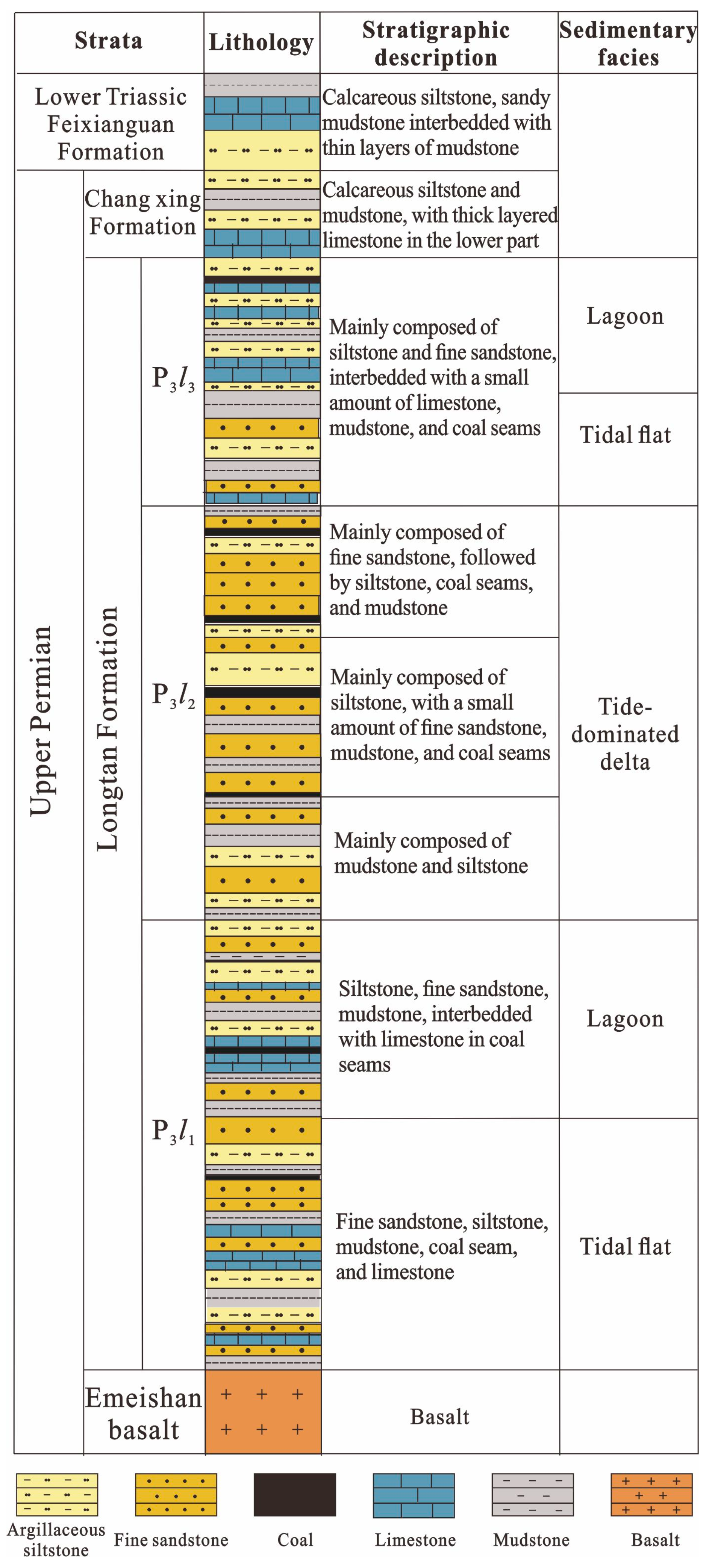
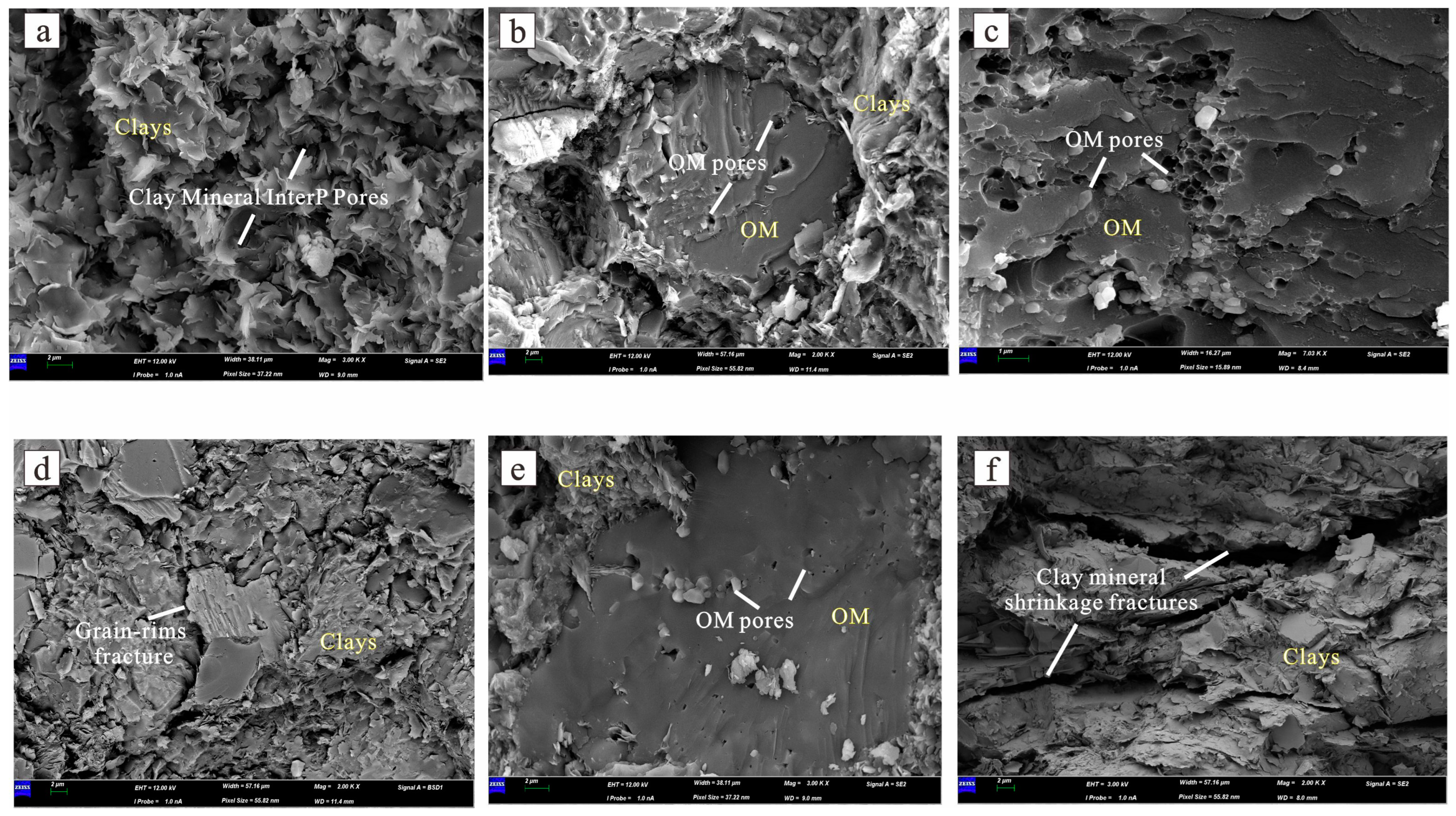
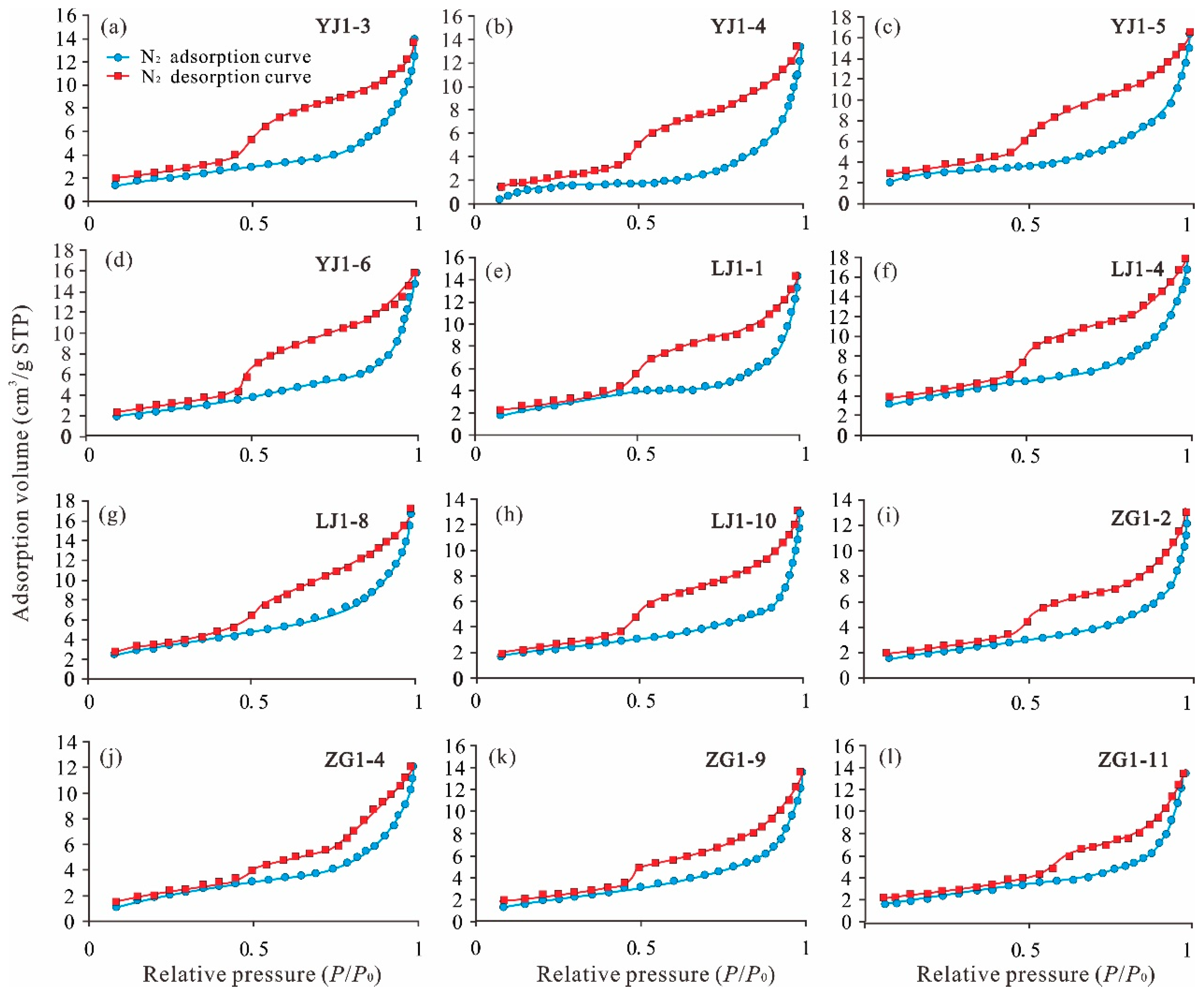
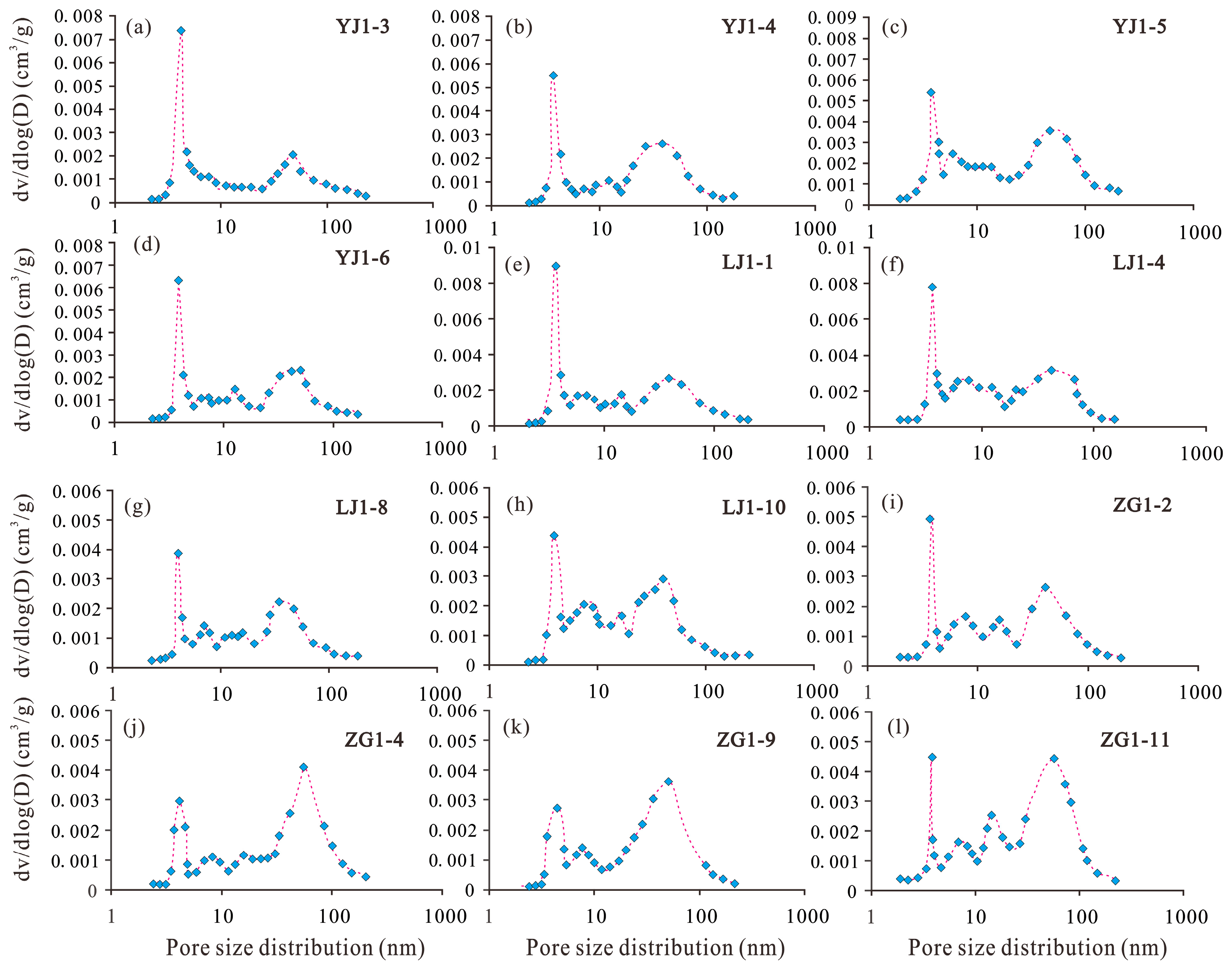
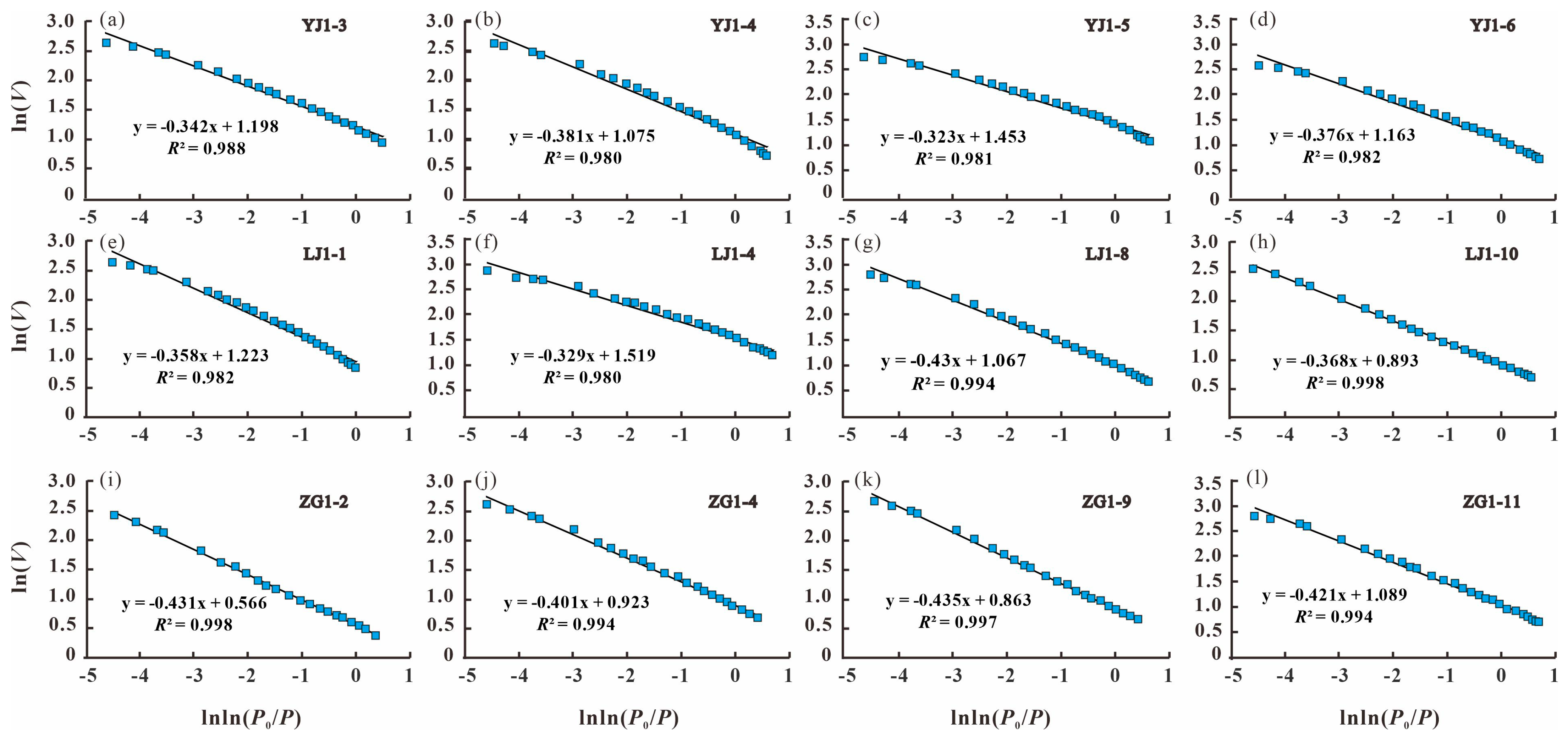





| Sample ID | Depth/m | Sedimentary Facies | TOC/% | Clay | Quartz | Orthoclase | Anorthose | Calcite | Dolomite | Pyrite | Others |
|---|---|---|---|---|---|---|---|---|---|---|---|
| YJ1-3 | 3026.56 | Tidal flat | 6.60 | 62.07 | 20.55 | 1.76 | 2.60 | 4.50 | 3.82 | 1.58 | 3.13 |
| YJ1-4 | 3029.85 | Tidal flat | 6.36 | 59.70 | 21.84 | 2.64 | 4.34 | 4.50 | 3.24 | 1.11 | 2.64 |
| YJ1-5 | 3034.60 | Lagoon | 7.14 | 67.00 | 17.88 | 1.76 | 1.73 | 4.50 | 3.15 | 2.31 | 1.67 |
| YJ1-6 | 3049.99 | Lagoon | 6.11 | 61.02 | 21.12 | 1.76 | 2.60 | 5.39 | 4.20 | 1.92 | 1.99 |
| LJ1-1 | 3164.87 | Lagoon | 5.50 | 64.54 | 19.22 | 1.76 | 1.73 | 4.50 | 3.82 | 1.57 | 2.87 |
| LJ1-4 | 3175.16 | Lagoon | 7.98 | 67.70 | 17.50 | 1.76 | 0.87 | 2.70 | 4.77 | 2.11 | 2.59 |
| LJ1-8 | 3179.30 | Lagoon | 3.77 | 49.31 | 26.74 | 3.52 | 2.60 | 5.39 | 2.67 | 4.57 | 5.19 |
| LJ1-10 | 3180.32 | Lagoon | 4.82 | 55.91 | 23.89 | 4.40 | 5.20 | 1.80 | 3.15 | 3.43 | 2.22 |
| ZG1-2 | 2948.80 | Tidal flat | 2.20 | 44.38 | 30.14 | 6.15 | 2.60 | 2.90 | 2.48 | 5.86 | 5.49 |
| ZG1-4 | 2949.20 | Lagoon | 4.54 | 47.82 | 23.22 | 3.52 | 1.73 | 0.90 | 5.82 | 4.30 | 12.70 |
| ZG1-9 | 2952.50 | Lagoon | 2.39 | 47.90 | 25.34 | 6.15 | 2.60 | 0.08 | 6.87 | 6.20 | 4.85 |
| ZG1-11 | 2974.70 | Lagoon | 4.12 | 55.40 | 24.17 | 4.40 | 5.20 | 2.70 | 3.24 | 1.43 | 3.46 |
| Sample ID | Total Pore Volume (cm3/g) | Specific Surface Area (m2/g) | Average Pore Diameter (nm) | Sample ID | Total Pore Volume (cm3/g) | Specific Surface Area (m2/g) | Average Pore Diameter (nm) |
|---|---|---|---|---|---|---|---|
| YJ1-3 | 0.028 | 10.32 | 74.06 | LJ1-8 | 0.020 | 7.42 | 81.88 |
| YJ1-4 | 0.021 | 7.36 | 55.95 | LJ1-10 | 0.024 | 7.08 | 97.86 |
| YJ1-5 | 0.026 | 11.71 | 56.78 | ZG1-2 | 0.019 | 5.02 | 113.11 |
| YJ1-6 | 0.027 | 9.63 | 67.01 | ZG1-4 | 0.026 | 7.94 | 97.74 |
| LJ1-1 | 0.026 | 10.23 | 64.44 | ZG1-9 | 0.019 | 6.47 | 103.88 |
| LJ1-4 | 0.027 | 12.87 | 57.26 | ZG1-11 | 0.022 | 8.02 | 88.22 |
| Sample ID | Fractal Fitting Equation | D | R2 | Sample ID | Fractal Fitting Equation | D | R2 |
|---|---|---|---|---|---|---|---|
| YJ1-3 | y = −0.3421x + 1.1987 | 2.6579 | 0.9882 | LJ1-8 | y = −0.4300x + 1.0673 | 2.5700 | 0.9946 |
| YJ1-4 | y = −0.3811x + 1.0757 | 2.6189 | 0.9805 | LJ1-10 | y = −0.3681x + 0.8930 | 2.6319 | 0.9988 |
| YJ1-5 | y = −0.3232x + 1.4537 | 2.6768 | 0.9811 | ZG1-2 | y = −0.4311x + 0.5666 | 2.5689 | 0.9987 |
| YJ1-6 | y = −0.3767x + 1.1639 | 2.6233 | 0.9822 | ZG1-4 | y = −0.4018x +0.9234 | 2.5982 | 0.9946 |
| LJ1-1 | y = −0.3587x + 1.2238 | 2.6413 | 0.9826 | ZG1-9 | y = −0.4359x + 0.8632 | 2.5641 | 0.9976 |
| LJ1-4 | y = −0.3292x + 1.5197 | 2.6708 | 0.9803 | ZG1-11 | y = −0.4214x + 1.0898 | 2.5786 | 0.9944 |
Disclaimer/Publisher’s Note: The statements, opinions and data contained in all publications are solely those of the individual author(s) and contributor(s) and not of MDPI and/or the editor(s). MDPI and/or the editor(s) disclaim responsibility for any injury to people or property resulting from any ideas, methods, instructions or products referred to in the content. |
© 2024 by the authors. Licensee MDPI, Basel, Switzerland. This article is an open access article distributed under the terms and conditions of the Creative Commons Attribution (CC BY) license (https://creativecommons.org/licenses/by/4.0/).
Share and Cite
Zhang, J.; Lin, W.; Li, M.; Wang, J.; Xiao, X.; Chen, Y. Pore Structure and Heterogeneity Characteristics of Coal-Bearing Marine–Continental Transitional Shales from the Longtan Formation in the South Sichuan Basin, China. Minerals 2024, 14, 588. https://doi.org/10.3390/min14060588
Zhang J, Lin W, Li M, Wang J, Xiao X, Chen Y. Pore Structure and Heterogeneity Characteristics of Coal-Bearing Marine–Continental Transitional Shales from the Longtan Formation in the South Sichuan Basin, China. Minerals. 2024; 14(6):588. https://doi.org/10.3390/min14060588
Chicago/Turabian StyleZhang, Jizhen, Wei Lin, Mingtao Li, Jianguo Wang, Xiao Xiao, and Yuchuan Chen. 2024. "Pore Structure and Heterogeneity Characteristics of Coal-Bearing Marine–Continental Transitional Shales from the Longtan Formation in the South Sichuan Basin, China" Minerals 14, no. 6: 588. https://doi.org/10.3390/min14060588
APA StyleZhang, J., Lin, W., Li, M., Wang, J., Xiao, X., & Chen, Y. (2024). Pore Structure and Heterogeneity Characteristics of Coal-Bearing Marine–Continental Transitional Shales from the Longtan Formation in the South Sichuan Basin, China. Minerals, 14(6), 588. https://doi.org/10.3390/min14060588









